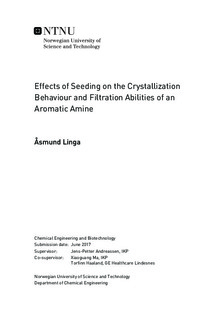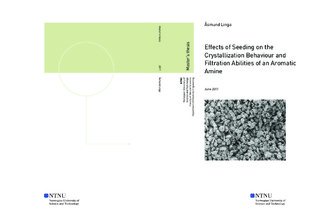| dc.description.abstract | One of the intermediates in the production of X-ray contrast agents at GE Healthcare Lindesnes, commonly referred to as an aromatic amine, is subject to a crystallization. Crystallization parameters such as size, size distribution and morphology have a strong impact on the subsequent filtration step in the production, where aromatic amine crystals are separated from the mother liquor. Seeding is a technique that allows for control of important crystal properties. The focus of this study is how variation of seeding parameters affects the crystallization behaviour of the aromatic amine, and how this can be connected to filtration abilities.
In this work, crystallization experiments have been carried out in a batch reactor followed by Nutsche filtration tests. Concentration of solute aromatic amine and chord lengths of particles have been measured through UV spectrophotometry and FBRM respectively. Samples of final crystals and filter cakes were analyzed in SEM. In general, experiments were performed in a synthetic solution based on composition data from the production.
Three seeding materials form the basis of this work; untreated, wet-milled and dry-milled seeds respectively. All materials have been applied at varying seeding ratios: 0.3, 1.7 and 3.3 g seeds/100 g final crystals. Extent of crystal growth was assumed independent of seeding ratio for untreated seeding. Growth on seed particles was most evident for dry-milled seeding. Secondary nucleation was most predominant for wet-milled seeding and was assumed proportional to seeding ratio for all applied materials.
A slurry addition of dry-milled seeds resulted in a slightly better filtration performance than a dry addition. Wet-milled seeding yielded a better filtration performance than untreated seeding at all tested seeding ratios. In terms of total surface area of seeds, a critical point was found at 1 m^2 seeds/100 g final crystals, where average specific cake resistance was reduced significantly.
Untreated seeding was performed at varying degrees of supersaturation. Seeding at a medium supersaturation indicated a high rate of secondary nucleation when no further HCl was added. A twofold increase in size of new-born crystals could be observed when seeding at a high supersaturation compared to a medium supersaturation. A transition from a synthetic to a process solution caused slightly improved filtration performances. | |

